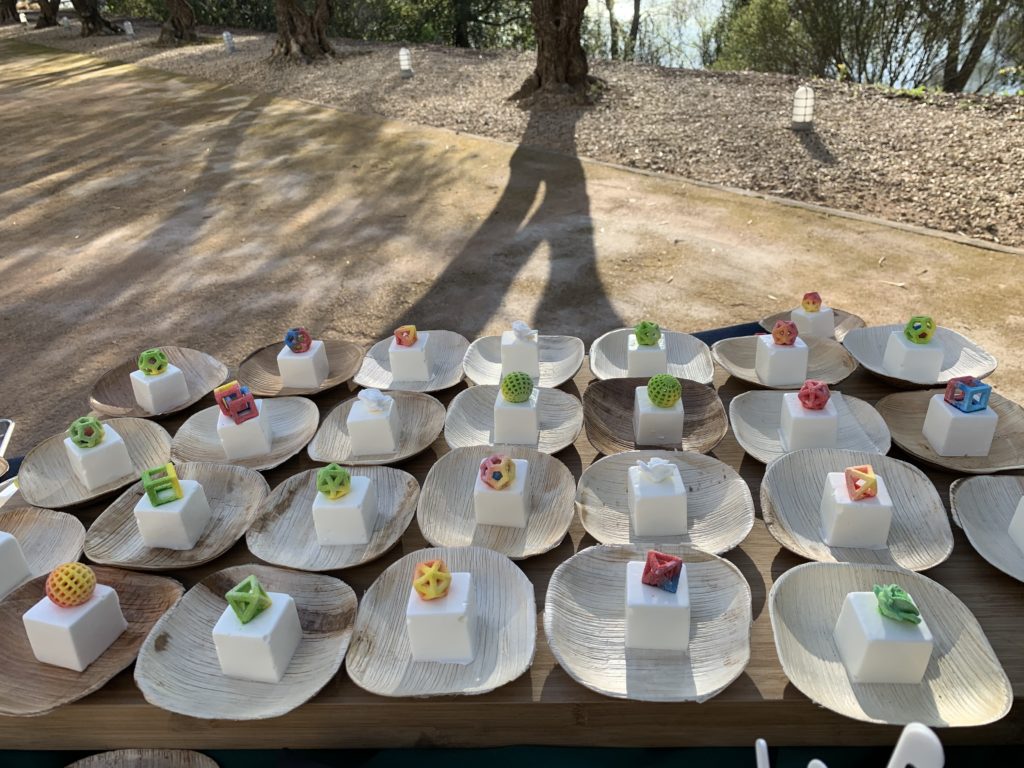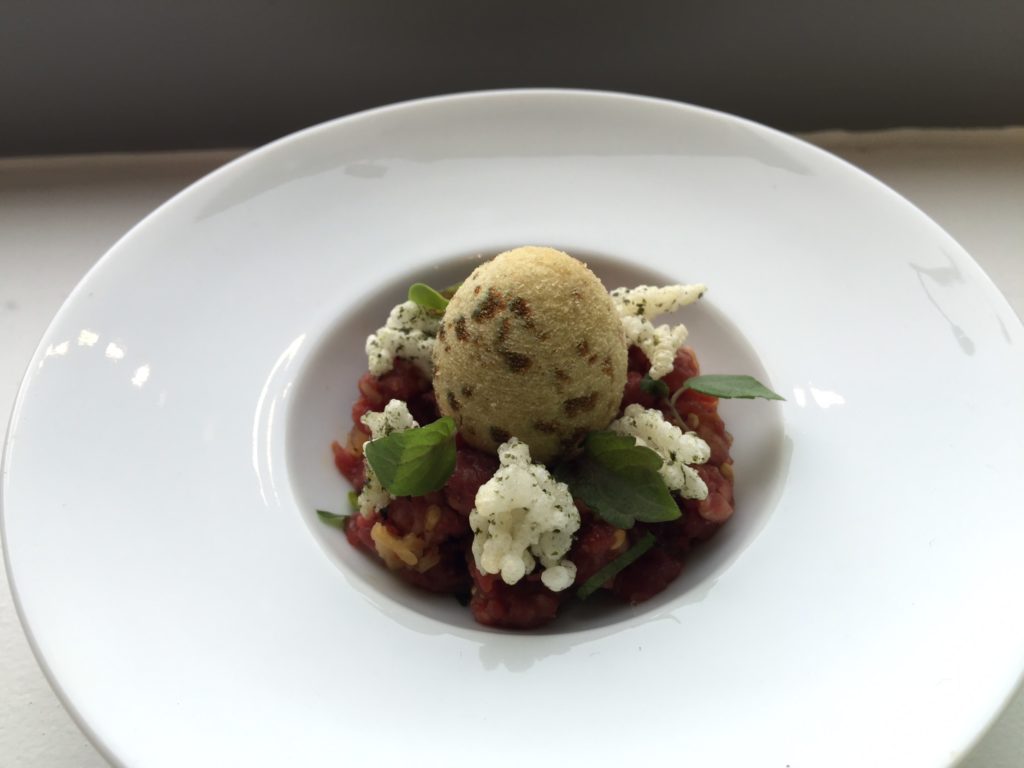As we’ve explored in our food 3D printing series, the technology is still emerging, with only a handful of food printing processes really approaching any form of maturity and level of commercialization. With those technologies that are on the market, we can catch a glimpse of how food 3D printing looks in the real world. In particular, we’re interested in how actual chefs might use the technology.
We spoke to users of the Brill 3D Culinary Studio powered by 3D Systems, including Top Chef winner Mei Lin, owner of Nightshade in Los Angeles, and Jimbo Irvin, Sous Chef at Local Three Kitchen & Bar in Atlanta. Both chefs have had hands-on experience with the technology and could attest to its potential applications.

An array of edible garnishes 3D printed using the Brill 3D Culinary Studio powered by 3D Systems. The garnishes are inspired by Coming 2 America. Image courtesy of Brill and Local Three.
In 2014, the CIA (not to be confused with the other CIA) had partnered with 3D Systems to introduce its student chefs to its sugar binder jetting technology, which uses edible liquid binders dyed to build full-color, printed sugar parts. Irvin was first exposed to what was then called the Chef Jet while enrolled in the school’s culinary science program. Then, in November 2019, what was now known as the 3D Culinary Studio was brought into Local Three for a two-week trial, where Irvin was able to see how far the technology had come as he produced large batches of sweets for customers.
According to Irvin, not only had the print quality improved, with sugar parts much less delicate with the new system, but so had the software:
“I was impressed with the whole setup, especially the software. It was very easy to use. I’m a chef, so I don’t have a whole lot of time to like sit down and mess with stuff. With that software, it was five, 10 minutes, lay out all of the models, you know, send it over to the printer and you’re ready to go.”
The items most frequently printed by Irvin were decorative sugar shapes that could be placed onto the rims of drinks. The 3D Culinary Studio comes with a catalogue of shapes, including templates for rim garnishes, but Local Three relied on the Brill and 3D Systems teams to help design custom geometries. This included a variety of designs that fit with Local Three’s regularly changing movie-related themes.

3D printed rimmers, including a Soul Glo hairspray bottle and the WhistlePig logo. Image courtesy of Brill and Local Three.
At the time that the restaurant used the 3D printer, it was focused on drawing actor Eddie Murphy into the venue as he and his fellow cast and crew filmed Coming 2 America in Atlanta. This meant using rim garnishes shaped like Soul Glo hairspray bottles and McDowell logo hamburger skewers. Additionally, Irvin and his team printed chess piece sugar cubes for coffee service at the restaurant’s adjacent private members’ club.
While the machine is capable of printing with a variety of flavors, including blue raspberry and cucumber, the restaurant stuck with non-flavored sugar prints. However, for one dinner hosted by whiskey maker WhistlePig, Local Three printed pig-shaped rimmers with the WhistlePig logo that were preserved in bacon fat, rather than the coconut oil typically used to maintain the sugar objects over time.
Depending on the size of the object, Irvin said that he was able to produce batches of up to 180 sugar garnishes, covering a two-week’s supply for the restaurant. Moreover, rim garnishes could be easily modified to match the specific rim size of a given piece of glassware, with the possibility of even greater customization had Local Three hung onto the system for longer. In total, Irvin estimated that, despite the upfront cost associated with such a machine, batch printing of sugar objects cost under 10 cents to produce.
Mei Lin, winner of one of Top Chef’s most competitive seasons, has been collaborating with 3D Systems since 2015, when she presented a number of unique dishes at the 3DS Culinary Lab in Los Angeles. Among the dishes she printed were an egg made from wasabi that garnished a Wagyu steak tartare. Once the egg was broken into, its warm center gushed onto the cool beef below. Her dessert featured a 3D printed flower that topped a passion fruit curd with toasted yogurt crumble.
Other dishes served at the event included a deconstructed French Onion soup made with a 3D printed onion powder cube made by Josiah Citrin of Santa Monica’s Mélisse and tequila- and gin-based cocktails with 3D printed maple-flavored garnishes and 3D printed smoked salt crystals created by Matthew Biancaniello.

Made by Mei Lin for the CIA Flavor Summit, Greek yogurt, passion fruit seed parfaits topped with 3D printed garnishes. Image courtesy of Mei Lin.
More recently, Lin showcased food printing technology at the CIA’s 2020 Flavor Summit where Chef Toni Sakaguchi from the CIA garnished “Whiskey Spiced Ginger Iced Tea” with ginger flavored lemon wedges. As shown in the demonstration video below, Lin made a Cantonese curry dish of shrimp toast and featuring fluorescent, 3D printed garnishes made of madras curry powder, as well as a carrot curry topped with leaves printed from kaffir lime powder and a Greek yogurt, passion fruit seed parfait that included a 3D printed vanilla flower.
“I just think that they’re a great way to add to your dish, texture-wise, flavor-wise. You can go with a neutral flavor, which is just plain or add an ingredient that adds to the flavor of your dish. Since this is a madras flavored curry, we added the madras curry powder to the actual print. That’ just an added touch to the actual dish.”
Like a traditional binder jetting system, the 3D Culinary Studio is large and requires a depowdering station. Both Irvin and Lin thought that, given the small size of many restaurants and the overall price of the equipment, it would be difficult to justify bringing the technology in-house—an issue that occurs in all industries when businesses consider the adoption of industrial 3D printing technology.

3D printed ginger-flavored lemon wedges garnishing Whiskey Spiced Ginger Iced Tea. Image courtesy of Brill.
In turn, companies in the hospitality industry—such as hotels, event venues and cruise lines—may be more likely to acquire industrial food printing systems. Fortunately for chefs who wish to explore food printing, there may be a market for food printing services. The co-founder of the The Sugar Lab and inventor of 3D Systems’ food printing technology, Kyle von Hasseln has founded Culinary Printworks. von HasseIn, who served as the product manager for 3D Systems food printing line, has established what may truly be the first and only on-demand 3D food manufacturing company. von Hasseln explained:
“For every chef that’s able to bring the technology in house, there are probably nine others that aren’t really ready to purchase the hardware on day one or maybe will never actually purchase it. We work with any chef or marketing director on a one-on-one experience. They’ll describe the kind of event they’re having. We’ll help them design that food and then print it and ship that food to them.”
While Brill will provide hardware and materials, as well as the necessary training and installation, for businesses that are ready to invest in food printers, Culinary Printworks can produce printed food for those that can’t yet justify the investment. The company is based in Los Angeles but has plans to expand to other large cities. Regardless of location, the firm will be able to provide services over the internet.
Regardless of how food printing makes its way into restaurants, the chefs we spoke to were excited about the possibilities. Lin told 3DPrint.com, “3D printing allows you to be creative with different flavors and textures that you wouldn’t be able to create with the human hand.” She was also interested in the possibilities of what ingredients could be used, saying, “Cricket powder is something that I have seen in 3D printing and it has a tremendous amount of protein.”
Irvin highlighted the entertainment value it had for diners, “It drummed up conversations with our customers. We’d drop off the cocktail or the burger and they’d be like, what is this? And we’d be able to explain kind of the technology and, all of a sudden, we’re having a conversation; we’re engaging with the customer.”
Subscribe to Our Email Newsletter
Stay up-to-date on all the latest news from the 3D printing industry and receive information and offers from third party vendors.
You May Also Like
3D Printing News Briefs, April 13, 2024: Robotics, Orthotics, & Hypersonics
In 3D Printing News Briefs today, we’re focusing first on robotics, as Carnegie Mellon University’s new Robotics Innovation Center will house several community outreach programs, and Ugogo3D is now working...
Rail Giant Alstom Saves $15M with 3D Printing Automation Software 3D Spark
3D Spark has entered into a three-year deal with the rail giant Alstom. Alstom, a transport behemoth with annual revenues of $16 billion, specializes in the manufacture of trains, trams,...
Meltio Expands Global Reach with New Partnerships in the Americas and Europe
Spanish 3D printing manufacturer Meltio has expanded its sales network across the globe. With the addition of three new partners in the United States, Brazil, Argentina, and Italy, Meltio aims...
3D Printing Webinar and Event Roundup: April 7, 2024
Webinars and events in the 3D printing industry are picking back up this week! Sea-Air-Space is coming to Maryland, and SAE International is sponsoring a 3D Systems webinar about 3D...
































